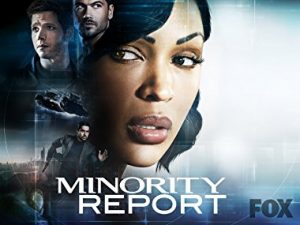The “Minority Report” TV series (2015, Fox) changes its focus from the 2002 Steven Spielberg film’s futuristic action to characterization for the three precognitives – Dash, Arthur and Agatha. They are certainly sympathetic, having been enslaved by the state for eight years (which includes the film’s events), using their linked minds to see future crimes. But overall, this is a standard futuristic procedural, one that I mix up in my head with “Almost Human,” which I like slightly more.
Future seems familiar
“Minority Report” is set in a spy-state-controlled 2065. It’s not much different from today except that the tech is more advanced (touch-screens can be viewed from both sides, and there are no connecting cables anywhere) and the architecture is sheer and efficient (glass-walled offices). The “same society, new tech” vibe fits the Philip K. Dick brand, so go ahead and check that box.
The series begins where the film ends. Precrime has been abolished and the three precogs have been freed. Interestingly, despite Precrime being discredited as per the film’s events, the general public of 2065 Washington, D.C., has adapted to the spy state.

“Minority Report” (2015)
Fox, 10 episodes
Developed by: Max Borenstein
Starring: Stark Sands, Meagan Good, Nick Zano
Although it’s widely known that those imprisoned for precrime were innocent, and that their brains are now mush thanks to the brain-controlling halos they wore while imprisoned, the TV series shows no widespread outrage. This makes sense: Precrime’s evils only impacted a minority, and the majority remains comforted by the huge dropoff in (non-government-instituted) violent crime, even if Precrime itself was a crime. And the public doesn’t seem terribly bothered by the new metadata system, Hawk-Eye.
One of the series’ rare nods to the old-school notion of privacy weirdly comes from Akeela (Li Jun Li), one of our investigators’ allies at the DC police precinct. She wears facial-recognition-tricking tattoos. Her tattoos are always in the same place … so yeah, don’t think about it too hard.
Like the film, “Minority Report” is willing to show imperfections in the police (and the DIA, an FBI or CIA stand-in). But it doesn’t want to make citizens the bad guys. It knows viewers would sympathize with the citizens (since they are us).
Need baddies? Can’t go wrong with terrorists
So the pilot episode features a one-off terrorist willing to kill a bunch of innocents. And the series wraps with a bigger terror group called Memento Mori. Solid character actor Christopher Heyerdahl (“Peacemaker”) personifies the group.
Memento Mori aims to kill a Senate bill that will allow genetic manipulation that will save lives; it goes against God, they say. So “Minority Report’s” political binary is between state statism and religious statism. At least one liberty-minded character, Wally (Daniel London), does his best to live off the grid – although even he is a former state employee, having taken care of the precogs before they were freed.
As is common in this genre, “Minority Report” has it both ways: The state is all-encompassing, yet people can dodge it (or conversely, the agents can miss out on information) if the teleplay calls for it. Actors in the “Oh yeah, that guy” class like Steven Williams (“Total Recall 2070”) and Reed Diamond add gravitas – as does Wilmer Valderrama as the DCPD’s by-the-book leader — but the verisimilitude is lessened with each episode.
The state is rather incompetent relative to the tools at their disposal. They don’t have Precrime, but they have Hawk-Eye – and investigator Lara Vega (Meagan Good) can get this info sent right to her Google Glass-style contact lenses.
I doubt the writers are mimicking Dick’s general take on future governments. For one thing, there’s no satire or humorous absurdity to be found. For another, the “Minority Report” short story (1956) actually is rather pro-state: The protagonist (the head of Precrime) purposely preserves the system, figuring that his wrongful accusation came about only because he was privy to advanced knowledge.
The TV show’s random future predictions aren’t a bad replacement for satire, though. The Washington football team became the Red Clouds in 2019, one year before the Redskins name was retired in real life. In clubs, people get wristbands at the door that will tell them their compatibility odds with other patrons – an instant matchmaking algorithm.
Cast is easy to like
Before the writers learned they’d only get 10 episodes (cut back from an initial 13), they made procedural episodes, and tried to do so with style. Good reminds me of a shorter Jessica Alba from “Dark Angel” – wearing tank tops and leather jackets, sticking out her hip and looking sassy. She tones this down in later episodes.
Good nicely pairs with Stark Sands as Dash, the one precog who – unlike his milk-bath brother and sister — wants to help the police and DIA catch bad guys. Dash is at a disadvantage because he only sees images of the future crimes.
Nick Zano (“Legends of Tomorrow”) plays Arthur, who only sees numbers in the future crimes; he loves life in the capital city. Laura Regan plays Agatha, on whom the visions are most personal, because she connects with the victims’ fear; she hides out on a barrier island in the Carolinas that was a peninsula before the rising ocean level cut it off from the mainland.
By the end of my rewatch, I had forgotten the procedural episodes and retained the personal episodes, which perhaps is to the series’ credit. One hour flashes back to right after the precogs were released to live freely. It’s especially cute to see Arthur – who we know as suave and cocky – bumble his way through meeting a female bartender, the first person who smiles at him. This thread ends too soon.
Another episode hints at Dash being attracted to Vega. Amusingly, Dash peruses the photo screen (on the wall like a framed photo) in her house and pauses on one of Lara in a bikini – not realizing the photos are also showing on the giant wall screen. This “attraction between partners” thread is a cliché, but I could’ve gone for more of it, if only as a garnish.
Losing its edge
As it goes along – perhaps absorbing the fact that it’ll only get 10 episodes — “Minority Report” sticks to its core premise and loses some personality. The production values are high, but familiar. The show doesn’t repeat the sepia tones of Spielberg’s movie, perhaps because those had become a cliché by 2015. But it brings back the jittery camera in the rare case of an action sequence.
“Minority Report” has a sizable budget, but it lacks an edge. Granted, I like Vega and Dash and their allies. These 10 episodes are easy to watch, especially if you’re a fan of the film.
But if 2065 turns out to be like this TV series, it’s going to be a little disappointing. Granted, I expect the real 2065 to be worse than this TV world where the collapse (or inexplicable turnaround?) of the U.S. dollar is never brought up.
But what we do see is a world where the people have rolled over. Government has total reign even after its Precrime is discredited in spectacular fashion. In “Minority Report,” citizens have gotten lucky that the state’s evil has retreated to 2015 levels.


